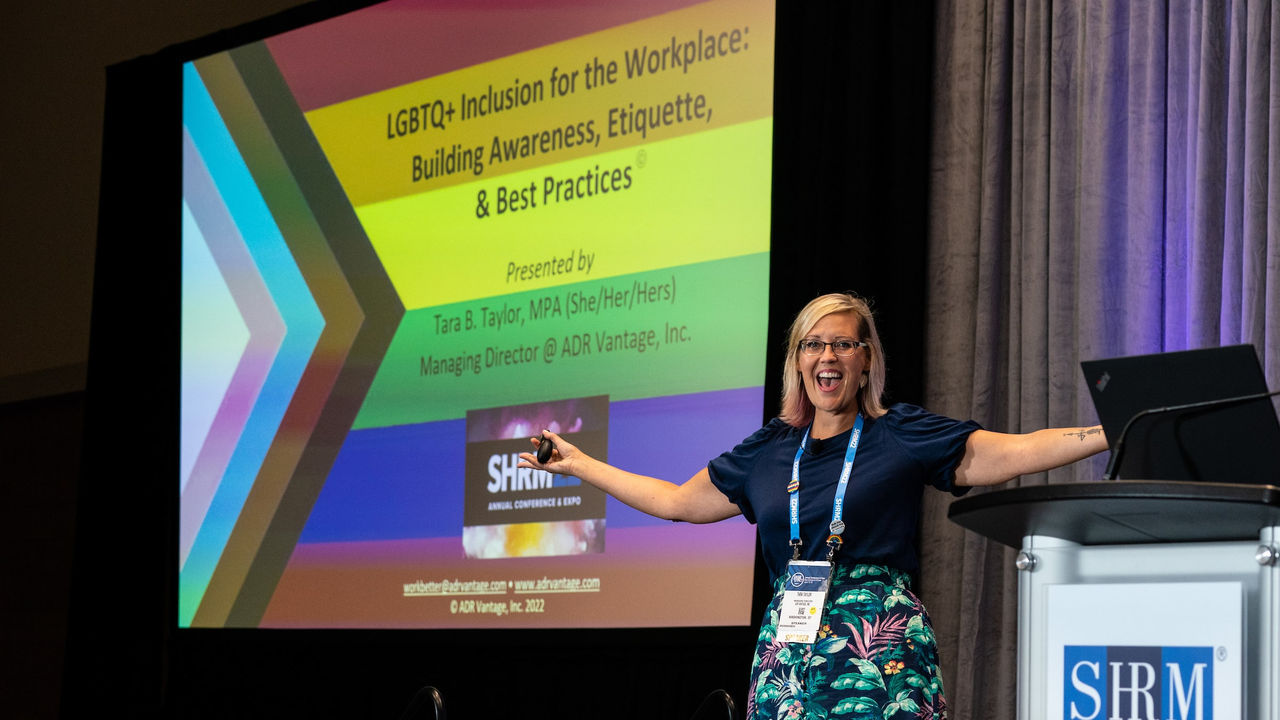
Until 2020, federal law did not specifically protect LGBTQ individuals from discrimination in the workplace.
That changed only two years ago, when the U.S. Supreme Court ruled in Bostock v. Clayton County that federal law protects LGBTQ workers from discrimination. The landmark ruling extended protections to millions of workers nationwide and changed the landscape for LGBTQ rights in the workplace for companies with 15 or more employees.
Yet many LGBTQ workers still find themselves feeling excluded, unwelcome and uncomfortable in their workplaces, which can increase stress levels and create additional psychological and physiological effects on these individuals.
On June 13, Tara Taylor, managing director of the Washington, D.C.-based business consultation firm ADR Vantage Inc., discussed the importance of LGBTQ inclusion in the workplace during a concurrent session, "LGBTQ+ Workplace Inclusion: Awareness, Etiquette, & Best Practices," at the SHRM Annual Conference & Expo 2022 in New Orleans.
"Eight percent of the U.S. population openly identifies as LGBTQ," Taylor said. "That is more than 25 million people, and 88 percent of them are employed. If you don't think they are in your workplace, they are."
Pronouns Explained
Taylor, who leads ADR Vantage's diversity, equity and inclusion (DE&I) consulting practice, began the session by familiarizing the audience with LGBTQ-inclusive terms and appropriate pronoun usage, such as:
- Traditional feminine: She/her.
- Traditional masculine: He/his.
- Gender-neutral: Ze/zir or they/their.
She also explained the differences between sex and gender:
- Biological sex: The label you are assigned by a doctor at birth based on the genitals you're born with and/or the chromosomes you have.
- Gender: A social and cultural construct. It's how your identity relates to society's idea of what it means to be a woman, man, neither or a mix of many genders.
- Gender identity: One's innermost concept of self as male, female, a blend of both or neither. Different cultures have different standards for how people are expected to behave based on their gender.
- Gender expression: The different ways you convey your gender, including your attire, behavior and appearance.
- Sexual orientation: Who you are attracted to.
"Identity doesn't always match behaviors, actions, appearance and outward expression," Taylor said. "Remember that next time someone doesn't identify as binary. It's up to them to decide their own identity. It's not our job to decide for them."
Best Practices for Companies to Consider
Taylor also outlined several tips for employers to consider when creating a more inclusive workspace for LGBTQ employees, including:
- Do not limit gender options on forms to "male" and "female." You can communicate inclusion by instead asking, "What is your gender?"
- Avoid using "other" as a gender option on forms. As Taylor said, "Nobody wants to be an 'other.' "
- Do not say "Miss," "Ms.," "Mrs." or "Mr." in e-mail correspondence unless you know how people describe themselves. Instead, you could use words like "applicant," "client," "customer" or "colleague."
- Tweak your HR information system to increase inclusivity. Ask your IT department about adding gender options.
- Be prepared to adapt to name changes. Workers who get married or divorced often change their names. It can be done for transgender employees just as easily.
- Avoid saying "sir" and "ma'am." As Taylor explained, "I know it's hard, and it relates to culture. But this small thing can help break down barriers." This is especially true when first meeting colleagues—don't try to guess their identities. Also, bypass terms like "guys" or "ladies" when referring to groups, even when they seem applicable.
- Add your pronouns to your e-mail signature. Taylor said this shows that employers "get it." You can do the same on your social media profiles, as well.
Employers should also learn more about the experiences of LGBTQ employees, become more familiar with inclusive language and terms, and examine their organizations to identify and eliminate practices that could be deemed exclusive to LGBTQ workers, Taylor said.
[SHRM members-only toolkit: Ensuring Workplace Inclusion for LGBTQ Employees]
She also noted that many companies are still unsure how to handle bathrooms for transgender workers. But she reminded the audience:
- Companies cannot ask employees to provide any medical or legal documentation regarding their gender identity in order to access bathroom facilities.
- Employees should not be required to use a facility apart from other employees because of their gender identity.
- Workers may not be limited by using facilities that are an unreasonable distance or travel time from the worksite.
Christina Lara, HR manager for Gila River Sand and Gravel Corp. in Sacaton, Ariz., said the information in Taylor's presentation is good knowledge for HR representatives and business leaders to consider.
"The information about how to handle preferred pronouns was particularly insightful," Lara said. "That way, you don't pinpoint a specific gender. I will absolutely bring the information I learned back with me to my work and implement these practices as much as possible. All HR representatives should."
An organization run by AI is not a futuristic concept. Such technology is already a part of many workplaces and will continue to shape the labor market and HR. Here's how employers and employees can successfully manage generative AI and other AI-powered systems.



